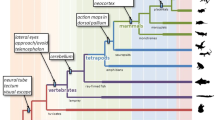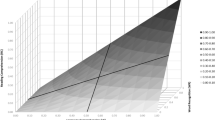Abstract
The aim of this study was to investigate the theory that visual magnocellular deficits seen in groups with dyslexia are linked to reading via the mechanisms of visual attention. Visual attention was measured with a serial search task and magnocellular function with a coherent motion task. A large group of children with dyslexia (n = 70) had slower serial search times than a control group of typical readers. However, the effect size was small (η 2p = 0.05) indicating considerable overlap between the groups. When the dyslexia sample was split into those with or without a magnocellular deficit, there was no difference in visual search reaction time between either group and controls. The data suggest that magnocellular sensitivity and visual spatial attention weaknesses are independent of one another. They also provide more evidence of heterogeneity in response to psychophysical tasks in groups with dyslexia. Alternative explanations for poor performance on visual attention tasks are proposed along with avenues for future research.



Similar content being viewed by others
References
Baddeley, A. (1986). Working memory. Oxford: Oxford University Press.
Bednarek, D. B., Saldana, D., Quintero-Gallego, E., Garcia, I., Grabowska, A., & Gomez, C. M. (2004). Attentional deficit in dyslexia: a general or specific impairment? NeuroReport, 15, 1787–1790.
Bonifacci, B., & Snowling, M. J. (2008). Speed of processing and reading disability: a cross-linguistic investigation of dyslexia and borderline intellectual functioning. Cognition, 107, 999–1017.
Breitmeyer, B. G. (1980). Unmasking visual masking: a look at the “why” behind the veil of “how”. Psychological Review, 87, 52–69.
Breitmeyer, B. G., & Ganz, L. (1976). Implications of sustained and transient channels for theories of visual patter making, saccadic suppression and information processing. Psychological Review, 83, 1–36.
Buchholz, J., & Aimola Davies, A. M. (2005). Adults with dyslexia demonstrate space-based and object-based covert attention deficits. Brain and Cognition, 57, 30–34.
Buchholz, J., & Aimola Davies, A. (2007). Attentional blink deficits observed in dyslexia depend upon task demands. Vision Research, 47, 1292–1302.
Buchholz, J., & McKone, E. (2004). Adults with dyslexia show deficits on spatial frequency doubling and visual attention tasks. Dyslexia, 10, 24–43.
Casco, C., Tessoldi, P. E., & Dellantonio, A. (1998). Visual selective attention and reading efficiency are related in children. Cortex, 34, 531–546.
Conlon, E. G., Sanders, M. A., & Wright, C. M. (2009). Relationships between global motion and global form processing, practice, cognitive and visual processing in adults with dyslexia or visual discomfort. Neuropsychologia, 47, 907–915.
Conlon, E., Sanders, M., & Zapart, S. (2004). Temporal processing in poor adult readers. Neuropsychologia, 42, 142–157.
Conlon, E. G., Wright, C. M., Norris, K., & Chekaluk, E. (2011). Does a sensory processing deficit explain counting accuracy on rapid visual sequencing tasks in adults with and without dyslexia? Brain and Cognition, 76, 197–205.
Cornelissen, P., Richardson, A., Mason, A., Fowler, S., & Stein, J. (1995). Contrast sensitivity and coherent motion detection measured at photopic luminance levels in dyslexics and controls. Vision Research, 10, 1483–1493.
de Jong, P. F. (1998). Working memory deficits of reading disabled children. Journal of Experimental Child Psychology, 70, 75–96.
Demb, J. B., Boynton, G. M., Best, M., & Heeger, D. J. (1998). Psychophysical evidence for a magnocellular pathway deficit in dyslexia. Vision Research, 38, 1555–1559.
Demb, J. B., Boynton, G. M., & Heeger, D. J. (1998). Functional magnetic imaging of early visual pathways in dyslexia. The Journal of Neuroscience, 18, 6939–6951.
Denckla, M. B., & Rudel, R. G. (1972). Color-naming in dyslexic boys. Cortex, 8, 164–176.
Eden, G., VanMeter, J., Rumsey, J., Maisog, J., Woods, R., & Zeffiro, T. (1996). Abnormal processing of visual motion in dyslexia revealed by functional brain imaging. Nature, 382, 66–69.
Enns, J. T., & Rensink, R. A. (1992). V Scope: general purpose tachistoscope for Macintosh. Vancouver: Micropsych Software.
Facoetti, A., Lorusso, M. L., Paganoni, P., Cattaneo, C., Galli, R., & Mascetti, G. G. (2003). The time course of attentional focusing in dyslexic and normally reading children. Brain and Cognition, 53, 181–184.
Facoetti, A., Paganoni, P., & Lorusso, M. L. (2000). The spatial distribution of visual attention in developmental dyslexia. Experimental Brain Research, 132, 531–538.
Facoetti, A., Turatto, M., Lorusso, M. L., & Mascetti, G. G. (2001). Orienting of visual attention in dyslexia: evidence for asymmetrical hemispheric control of attention. Experimental Brain Research, 138, 46–53.
Facoetti, A., Zorzi, M., Cestnick, L., Lurusso, M. L., Molteni, M., Paganoni, P., et al. (2006). The relationship between visuo-spatial attention and nonword reading in developmental dyslexia. Cognitive Neuropsychology, 23, 841–855.
Fawcett, A. J., & Nicolson, R. I. (1994). Naming speed in children with dyslexia. Journal of Learning Disabilities, 27, 641–646.
Fawcett, A. J., & Nicolson, R. I. (1996). The Dyslexia Screening Test. London: The Psychological Corporation.
Felmingham, K. L., & Jakobson, L. S. (1995). Visual and visuomotor performance in dyslexic children. Experimental Brain Research, 106, 467–474.
Fletcher, J. M., Francis, D. J., Morris, R. D., & Lyon, G. R. (2005). Evidence-based assessment of learning disabilities in children and adolescents. Journal of Clinical Child and Adolescent Psychology, 34, 506–522.
Friedmann, N., Kerbel, N., & Shvimer, L. (2010). Developmental attentional dyslexia. Cortex, 46, 1216–1237.
Goulandris, N., McIntyre, A., Snowling, M. J., Bethel, J. M., & Lee, J. P. (1998). A comparison of dyslexic and normal readers using orthoptic assessment procedures. Dyslexia, 4, 30–48.
Hansen, P. C., Stein, J. F., Orde, S. R., Winter, J. L., & Talcott, J. B. (2001). Are dyslexics’ visual deficits limited to measures of dorsal stream function? NeuroReport, 12, 1527–1530.
Hari, R., Valta, M., & Uutela, K. (1999). Prolonged attentional dwell time in dyslexic adults. Neuroscience Letters, 271, 202–204.
Hatcher, P. (2000). Sound linkage: an integrated program for overcoming reading difficulties. London: Whurr.
Iles, J., Walsh, V., & Richardson, A. (2000). Visual search performance in dyslexia. Dyslexia, 6, 163–177.
Kaernbach, C. (1991). Simple adaptive testing with the weighted up-down method. Perception & Psychophysics, 49, 227–229.
Kubova, Z., Kuba, M., Peregrin, J., & Novakova, V. (1996). Visually evoked potential evidence for magnocellular system deficit in dyslexia. Physiological Research, 45, 87–89.
Lehmkuhle, S. M., Garzia, R. P., Turner, L., Hash, T., & Baro, J. A. (1993). A defective visual pathway in children with reading disability. The New England Journal of Medicine, 328, 989–996.
Lovegrove, W. J., Martin, F., & Slaghuis, W. (1986). A theoretical and experimental case for a visual deficit in specific reading disability. Cognitive Neuropsychology, 3, 225–267.
Lyon, G. R., Shaywitz, S. E., & Shaywitz, B. A. (2003). A definition of dyslexia. Annals of Dyslexia, 53, 1–14.
Nicolson, R. I., & Fawcett, A. J. (1994). Reaction times and dyslexia. Quarterly Journal of Experimental Psychology. A, Human Experimental Psychology, 47A, 29–48.
Olson, R., Forsberg, H., Wise, B., & Rack, J. (1994). Measurement of word recognition, orthographic and phonological skills. In G. Reid Lyon (Ed.), Frames of reference for the assessment of learning disabilities: new views on measurement issues (pp. 243–278). Baltimore: Brookes.
Ramus, F., Rosen, S., Dakin, S. C., Day, B. L., Catelotte, J. M., White, S., et al. (2003). Theories of developmental dyslexia: insights from a multiple case study of dyslexic adults. Brain, 126, 841–865.
Raven, J. C., Court, J. H., & Raven, J. (1995). Coloured progressive matrices. Oxford: Oxford Psychologists Press.
Roach, N. W., & Hogben, J. H. (2004). Attentional modulation of visual processing in adult dyslexia: a spatial cueing deficit. Psychological Science, 15, 650–654.
Roach, N. W., & Hogben, J. H. (2007). Impaired filtering of behaviorally irrelevant visual information in dyslexia. Brain, 130, 771–785.
Savage, R. (2004). Motor skills, automaticity and developmental dyslexia. Reading and Writing, 17, 301–324.
Semrud-Clikeman, M., Biederman, J., Sprich-Buckminster, S., Lehman, B. K., Faraone, S. V., & Norman, D. (1992). Comorbidity between ADDH and LD: a review and report in a clinically referred sample. Journal of the American Academy of Child and Adolescent Psychiatry, 31, 439–448.
Shanahan, M. A., Pennington, B. F., Yerys, B. E., Scott, A., Boada, R., Willcutt, E. G., et al. (2006). Processing speed deficits in attention deficit/hyperactivity disorder and reading disability. Journal of Abnormal Child Psychology, 34, 584–602.
Shaywitz, S., Escobar, M., Shaywitz, B., Fletcher, J., & Makugh, R. (1992). Evidence that dyslexia may represent the lower tail of a normal distribution of reading ability. The New England Journal of Medicine, 326, 145–150.
Sireteanu, R., Goebel, C., Goertz, R., & Wandert, T. (2005). Do children with developmental dyslexia show a selective visual attention deficit? Strabismus, 14, 85–93.
Sireteanu, R., Goebel, C., Goertz, R., Werner, I., Nalewajko, M., & Thiel, A. (2008). Impaired visual search in children with developmental dyslexia. Annals of the New York Academy of Sciences, 1145, 199–211.
Skottun, B. C. (2000). The magnocellular deficit theory of dyslexia: the evidence from contrast sensitivity. Vision Research, 40, 111–127.
Slaghuis, W. L., & Ryan, J. F. (2006). Directional motion contrast sensitivity in developmental dyslexia. Vision Research, 46, 3291–3303.
Smith-Spark, J. H., & Fisk, J. E. (2006). Working memory functioning in developmental dyslexia. Memory, 15, 34–56.
Snowling, M. J. (2000). Dyslexia. Oxford: Blackwell.
Stein, J. F., & Fowler, M. S. (1980). Visual dyslexia. British Orthopedic Journal, 37, 11.
Stein, J. F., & Fowler, M. S. (1981). Visual dyslexia. Trends in Neuroscience, 4, 77–80.
Stein, J. F., & Fowler, M. S. (1985). Effect of monocular occlusion on visuomotor perception and reading in dyslexic children. Lancet, 2(8446), 69–73.
Stein, J. F., Fowler, M. S., & Richardson, A. (2000). Monocular occlusion can improve binocular control and reading in dyslexics. Brain, 123, 164–170.
Stein, J. F., Riddell, P. M., & Fowler, M. S. (1988). Disordered vergence control in dyslexic children. British Journal of Ophthalmology, 72, 162–166.
Stein, J., & Walsh, V. (1997). To see but not to read: the magnocellular theory of dyslexia. Trends in Neurosciences, 20, 147–152.
Steinman, S. B., Steinman, B. A., & Garzia, R. P. (1998). Vision and attention. II: is visual attention a mechanism through which a deficient magnocellular pathway might cause reading disability? Optometry and Vision Science, 75, 674–681.
Talcott, J. B., Hansen, P. C., Assoku, E. L., & Stein, J. F. (2000). Visual motion sensitivity in dyslexia: evidence for temporal and energy integration deficits. Neuropsychologia, 38, 935–943.
Torgesen, J. K., Wagner, R. K., Rashotte, C. A., Lindamood, P., Rose, E., Conway, T., et al. (1999). Preventing reading failure in young children with phonological processing disabilities: group and individual differences to instruction. Journal of Educational Psychology, 91, 579–593.
Triesman, A. M. (1988). Features and objects: the fourteenth Bartlett memorial lecture. Quarterly Journal of Experimental Psychology, 40A, 201–237.
Triesman, A. M., & Gelade, G. (1980). A feature integration theory of attention. Cognitive Psychology, 12, 97–136.
Triesman, A., & Sato, S. (1990). Conjunction search revisited. Journal of Experimental Psychology. Human Perception and Performance, 16, 459–478.
Valdois, S., Bosse, M. L., & Tainturier, M. J. (2004). Cognitive correlates of developmental dyslexia: review of evidence for a selective visual attentional deficit. Dyslexia, 10, 1–25.
Valdois, S., Gérard, C., Vanauld, P., & Dugas, M. (1995). Developmental dyslexia: a visual attentional account? Cognitive Neuropsychology, 12, 31–67.
Vellutino, F. R., Fletcher, J. M., Snowling, M. J., & Scanlon, D. M. (2004). Specific reading disability (dyslexia): what have we learned in the past four decades? Journal of Child Psychology and Psychiatry, 45, 2–40.
Vellutino, F. R., Scanlon, D. M., Sipay, E. R., Small, S. G., Pratt, A., Chen, R., et al. (1996). Cognitive profiles of difficult-to-remediate and readily remediated poor readers: early intervention as a vehicle for distinguishing between cognitive and experiential deficits as basic causes of specific reading disability. Journal of Educational Psychology, 88, 601–638.
Vidyasagar, T. R. (1999). A neuronal model of attentional spotlight: parietal guiding the temporal. Brain Research Reviews, 30, 6–76.
Vidyasagar, T. R. (2004). Neural underpinnings of dyslexia as a disorder of visuo-spatial attention. Clinical & Experimental Optometry, 87, 4–10.
Vidyasagar, T. R., & Pammer, K. (1999). Impaired visual search in dyslexia relates to the role of the magnocellular pathway in attention. NeuroReport, 10, 1283–1287.
Vidyasagar, T., & Pammer, K. (2010). Dyslexia: a deficit in visuospatial attention, not in phonological processing. Trends in Cognitive Sciences, 14(2), 57–63.
Visser, T. A. W., Boden, C., & Giaschi, D. E. (2004). Children with dyslexia: evidence for visual attention deficits in perception of rapid sequences of objects. Vision Research, 44, 2521–2535.
Willcutt, E. G., Pennington, B. F., & DeFries, J. C. (2000). Twin study of the etiology of comorbidity between reading disability and attention-deficit/hyperactivity disorder. American Journal of Medical Genetics (Neuropsychiatric Genetics), 96, 293–301.
Willcutt, E. G., Pennington, B. F., Olson, R. K., Chhabildas, N., & Huslander, J. (2005). Neuropsychological analyses of comorbidity between reading disability and attention-deficit/hyperactivity disorder: in search of the common deficit. Developmental Neuropsychology, 27, 35–78.
Williams, M. C., Brannan, J. R., & Lartigue, E. K. (1987). Visual search in good and poor readers. Clinical Vision Sciences, 1, 367–371.
Wilmer, J. B., Richardson, A. J., Chen, Y., & Stein, J. F. (2004). Two visual motion processing deficits in developmental dyslexia associated with different reading skills deficits. Journal of Cognitive Neuroscience, 16, 1–13.
Witton, C., Stein, J. F., Stoodley, C. J., Rosner, B. S., & Talcott, J. B. (2002). Separate influences of acoustic AM and FM sensitivity on the phonological decoding skills if impaired and normal readers. Journal of Cognitive Neuroscience, 14, 866–874.
Wolf, M. (1991). Naming speed and reading: the contribution of the cognitive neuro-sciences. Reading Research Quarterly, 26, 123–141.
Wolf, M., & Bowers, P. G. (1999). The double-deficit hypothesis for the developmental dyslexias. Journal of Educational Psychology, 91, 415–438.
Wolf, M., O’Rourke, G. A., Gidney, C., Lovett, M., Cirino, P., & Morris, R. (2002). The second deficit: an investigation of the independence of phonological and naming-speed deficits in developmental dyslexia. Reading and Writing: An Interdisciplinary Journal, 15, 43–72.
Woodcock, R. W. (1997). Woodcock Diagnostic Reading Battery. Itasca: Riverside.
Wright, C. M., & Conlon, E. G. (2009). Auditory and visual processing in children with dyslexia. Developmental Neuropsychology, 34, 330–355.
Yule, W., Rutter, M., Berger, M., & Thompson, B. (1973). Over and under achievement in reading. British Journal of Educational Psychology, 44, 1–12.
Author information
Authors and Affiliations
Corresponding author
Rights and permissions
About this article
Cite this article
Wright, C.M., Conlon, E.G. & Dyck, M. Visual search deficits are independent of magnocellular deficits in dyslexia. Ann. of Dyslexia 62, 53–69 (2012). https://doi.org/10.1007/s11881-011-0061-1
Received:
Accepted:
Published:
Issue Date:
DOI: https://doi.org/10.1007/s11881-011-0061-1




